Family : Serranidae

Text © Giuseppe Mazza

English translation by Mario Beltramini
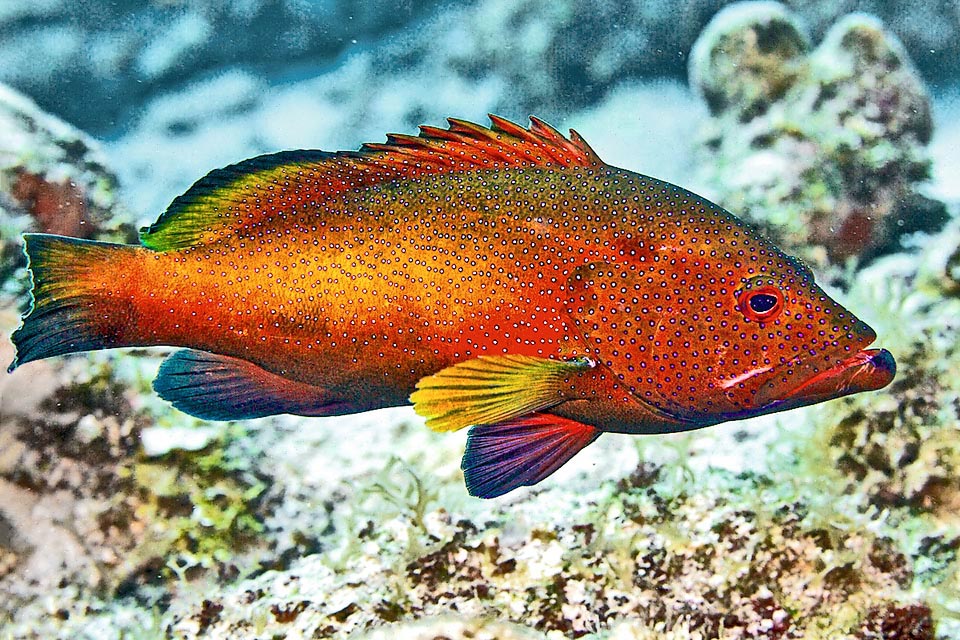
Seen like this Cephalopholis fulva looks like a gigantic grouper. The appearance is there but the current size is of about 25 cm © Allison & Carlos Estape
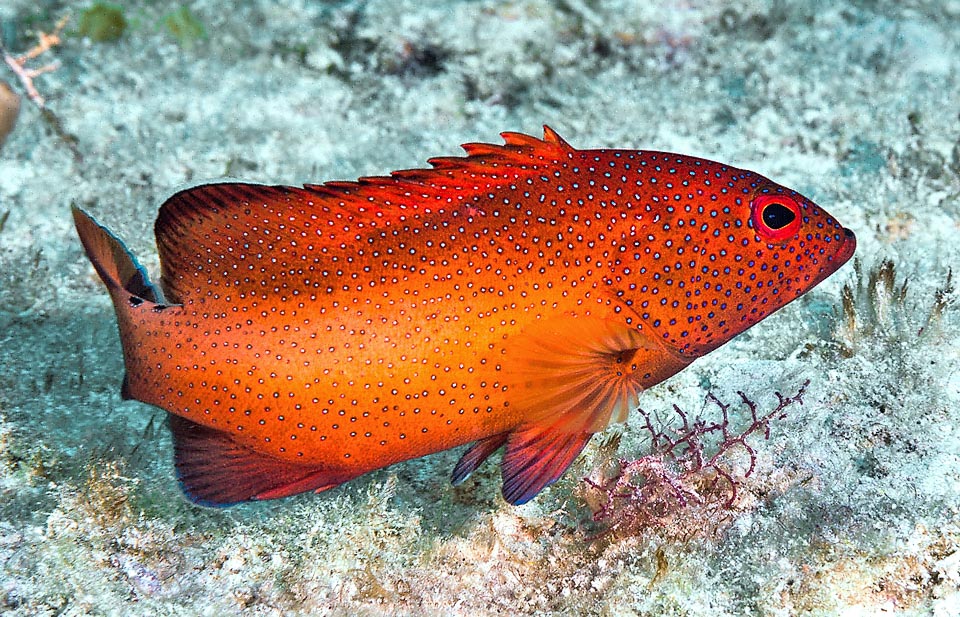
It lives in the West Atlantic preying upon fishes and crustaceans. This is its normal livery, reddish and slightly paler after the operculum, that may change instantly change © François Libert
Cephalopholis fulva (Linnaeus, 1758) belongs to the class of the Perciformes, the ray-finned fishes, to the family of the Serranidae, subfamily Epinephelinae, with some scholars preferring to isolate 16 genera with about 170 species, among which this one, in the family Epinephelidae.
The etymology of the genus Cephalopholis originates from the Greek “kephale”, head, and “pholis”, scale, with reference to the fact that the fore part of the snout, up to the nostrils, has no scales, whilst the specific term fulva, in Latin tawny, refers to the reddish colour of the livery.
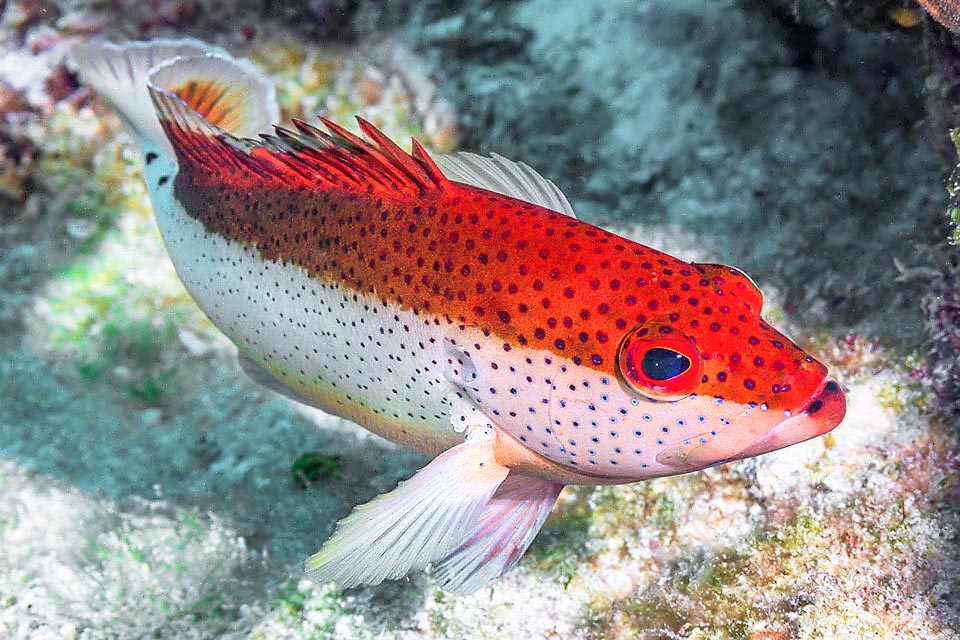
When stressed or excited in fact it appears like this. The only constant are 2 black spots on the back of the caudal peduncle and 2 more, here well visible, on the lower lip © François Libert
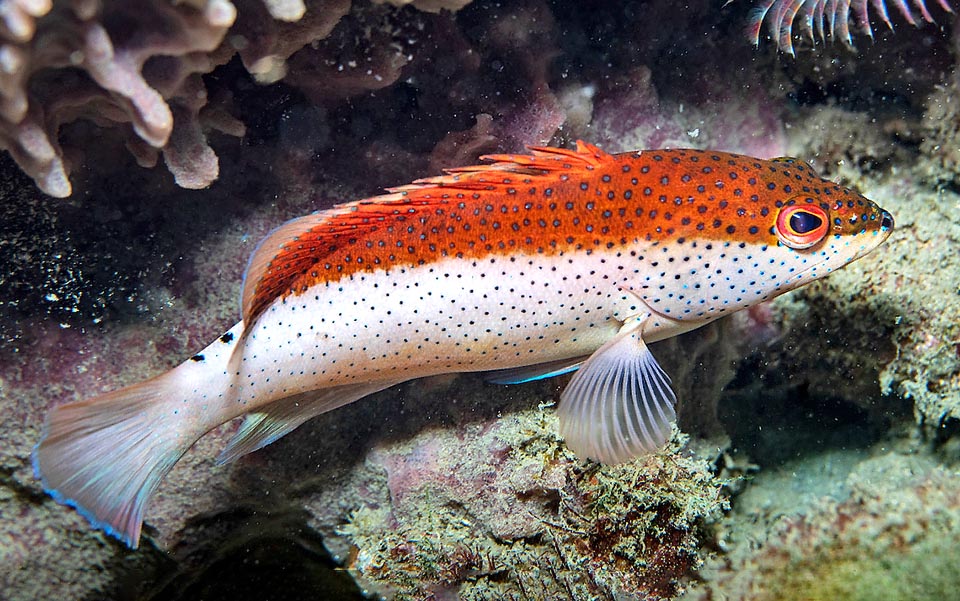
In these cases the back is tawny and all the rest is white, fins included, always keeping however a tiny blue punctuation © Allison & Carlos Estape
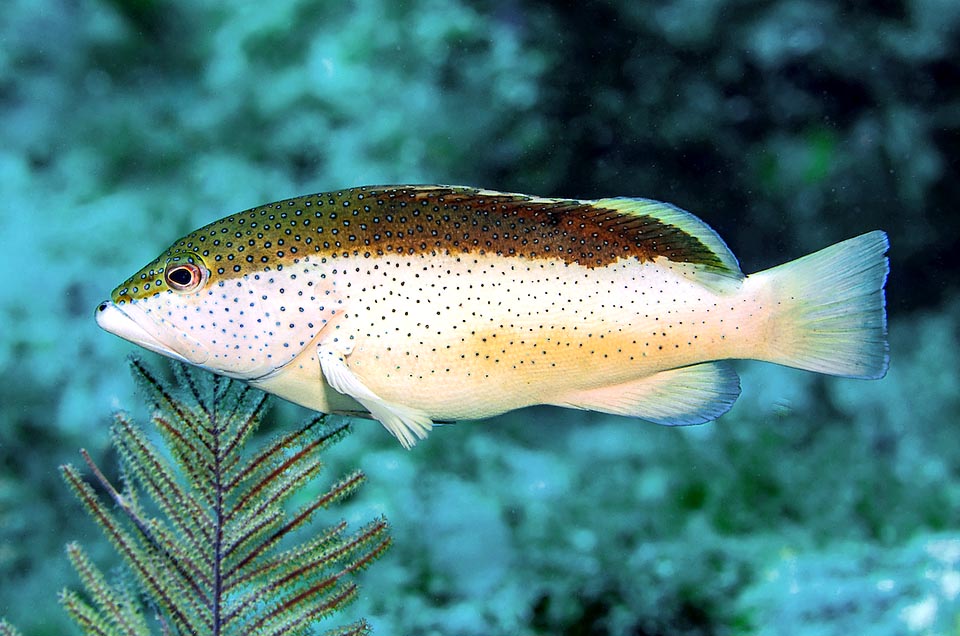
Sometimes the back can get very dark, and with all these colours, looking also the slender body of the young adults, Linnaeus had placed the specie in the wrasses © Allison & Carlos Estape
Zoogeography
Cephalopholis fulva lives in western Atlantic from South Carolina and the Bermudas up to the southern coasts of Brazil.
Ecology-Habitat
It frequents the clear waters of the madreporic formations, where it spends usually the hours of the day in a den at 5 to 30 m of depth, going vene lower in cerin sites like the Gulf of Mexico where it reaches the 45 m.
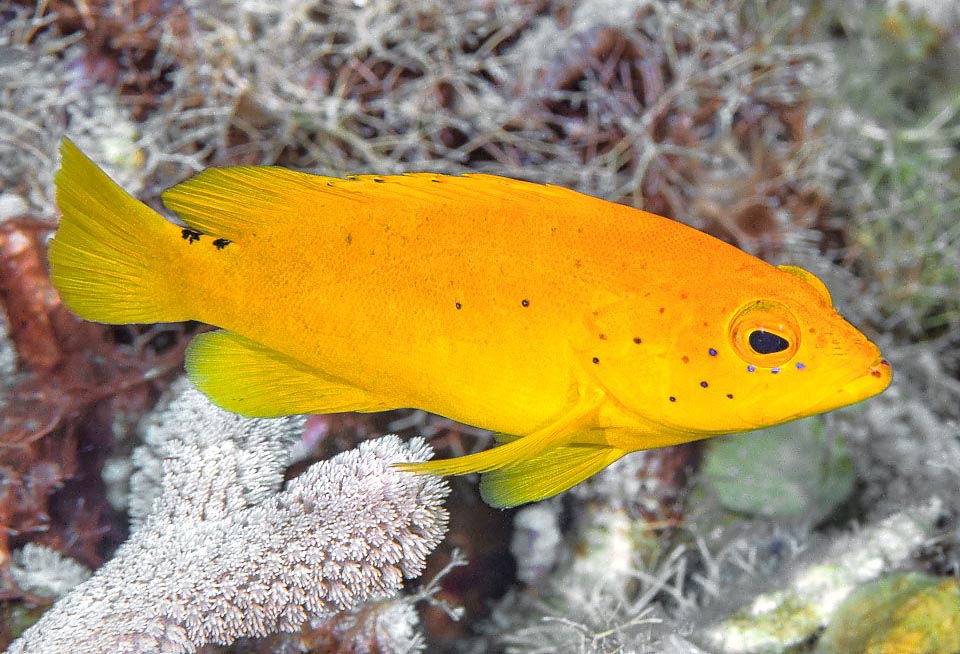
This is the yellow livery the fish rarely assumes. If it weren’t for the two small caudal points and on the lip that catch the eye we would say another species © François Libert
Morphophysiology
With a current size of 25 cm, Cephalopholis fulva stands by sure among the smallest existing groupers, if we consider that in the Mediterranean Epinephelus marginatus and Mycteroperca rubra may exceed 140 cm and that in Caribbean Epinephelus itajara reaches 2,5 m.
Cephalopholis fulva may reach the maximum of 44 cm, but for the rest the structure of the body is the same, robust and compact with a huge mouth, having the lower jaw protruding and big fleshy lips. When it opens wide a vacuum is created that sucks in the preys, swallowed whole or held by hundreds of small teeth present also on the tongue and the palate.
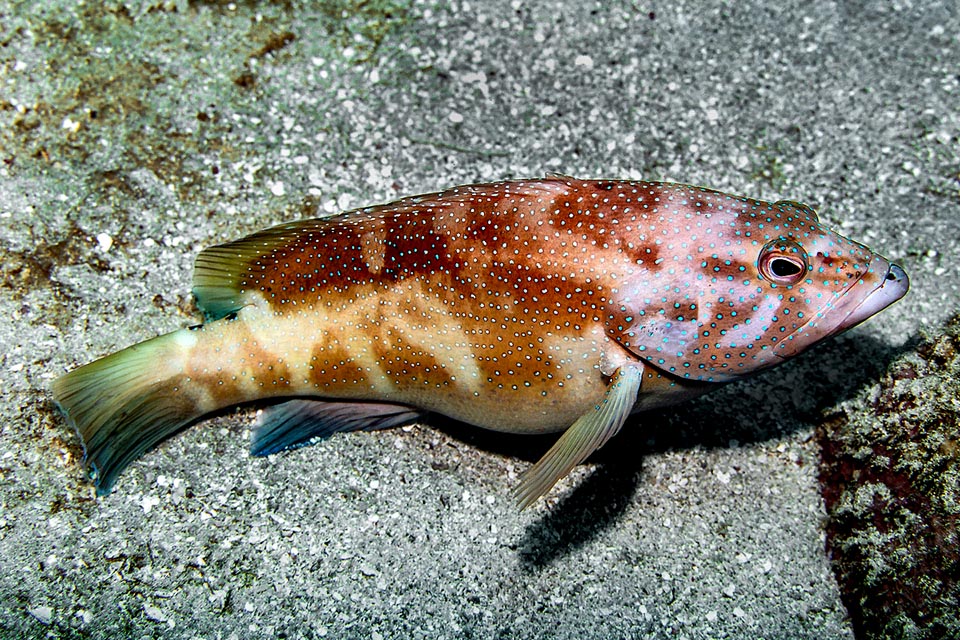
But surprises are not over, because when it’s night or rests on the sea beds, Cephalopholis fulva displays also this patchy mimetic suit © Allison & Carlos Estape
The livery is extremely variable depending on the depth and the mood of the fish, but in addition to the small blue points on the body, there are always two characteristic black spots on the back of the caudal peduncle and two more on the lower lip.
For the rest there are 4 typical configurations.
The most frequent is red-brown, with blueish pelvic fins and the anal.
The second, that appears at once when the fish is stressed or excited, is bicoloured, red-brown, or brown on the back with the rest of the body white, fins included.
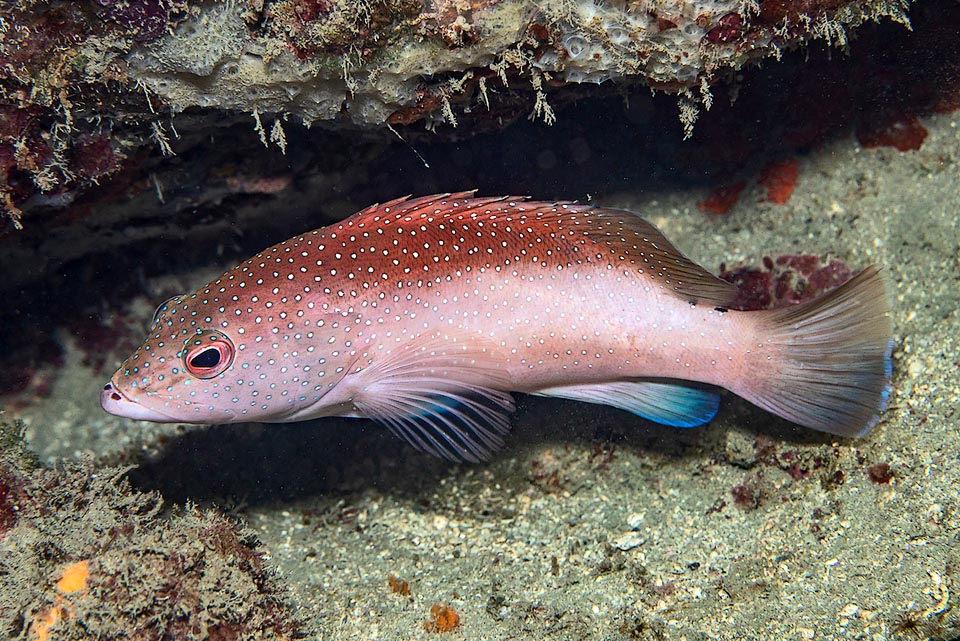
It’s protogynous hermaphrodite specie, with mature 16 cm females that can transform in territorial males when they reach 20 cm © Allison & Carlos Estape
In the third one, used rarely, the fish gets completely yellow with orange shades on the back, and in the fourth, exhibited at night, appears a mimetic drawing with contrasts between pale and dark zones.
In the juveniles, who have 4 black points more on the lower lip, the livery depends on the age.
At first they have on the brown back, in clear contrast on the neat body, a bright white spot close to the two black on a large black spot at the beginning of the soft dorsal rays and two not less showy caudal spots, close to the caudal black ones of the caudal peduncle, then growing, the whole fish gets yellow with blue small points .
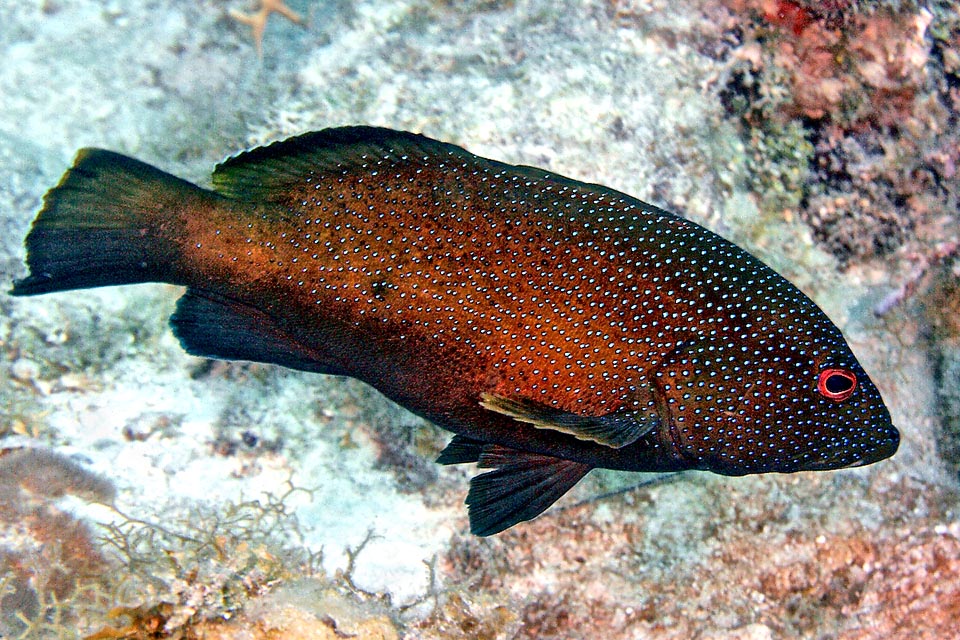
These have a harem and in the reproductive period each evening fecundate thousands of eggs. They measure 0,95 mm, go up floating on the surface, entrusted to currents © Allison & Carlos Estape
Ethology-Reproductive Biology
Cephalopholis fulva nourishes chiefly with fishes, it hunts, often motionless, but also with crabs and shrimps.
Like Cephalopholis argus, an Indian Ocean and West Pacific Ocean congener, at times goes side by side with the
moray eels using them as scouts. When they see them the small fishes run away terrified from the ravines where the moray eels can enter but not the grouper, and this one takes advantage of this with quick flashes.
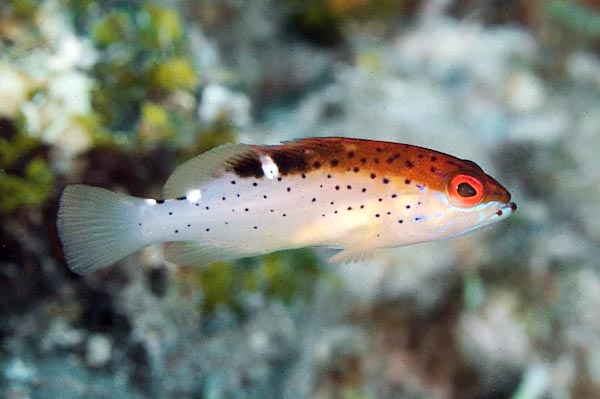
Juveniles, with 4 black points on the lower lip, get growing two liveries. In the first, bicoloured, they have a bright white spot at the beginning of the soft dorsal rays and two, near the black, on the caudal peduncle © Allison & Carlos Estape
Finally, also the grouper is not a loser, because four eyes see more than two in finding the fishes and half a meal is better than none.
Among the usual preys of this grouper stand the filefishes, such as Monacanthus tuckeri, the doctor fishes
Acanthurus coeruleus and the West Atlantic trumpetfish (Aulostomus maculatus) but at times it’s her ending up into the mouth of a voracious grouper more than double bigger than her: Epinephelus striatus.
Cephalopholis fulva is a protogynous hermaphroditic species, with the females reaching the sexual maturity around the 16 cm and can transform into territorial males with a harem when they reach 20 cm.
The reproductive period varies depending on the locations and spawning takes place just before the sunset.
The females that the male reviews every day to see if they are ready, may release 150.000-282.000 eggs each.
They measure O,95 mm and as soon as fecundated rise, floating to the surface thanks to an oily particle.
Entrusted to the currents, they hatch quickly and also the pelagic larvae and the juveniles grow up fast with a life expectancy, depending on the zone, of 25-28 years.
The resilience of the species is mediocre, with a possible doubling of the populations over 1,4-4,4 years, and the index of fishing vulnerability, high, marks 58 on a scale of 100.
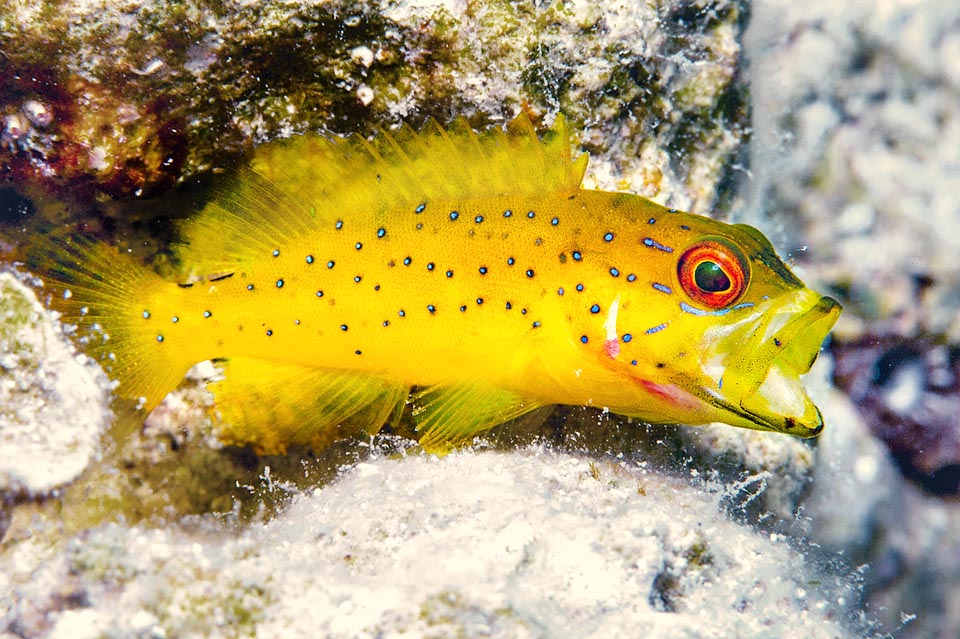
In the second all fish gets yellow with small blue points. Even if hunted by the sport fishermen, Cephalopholis fulva is not an endangered species © Allison & Carlos Estape
Although it is a modest sized fish and of poor commercial interest in fact it is locally caught with creels and hunted by sport fishermen, regardless of the fact that the flesh could be at risk of ciguatera if the grouper has preyed upon fishes that store in their diet the toxin produced by the dinoflagellate Gambierdiscus toxicus.
Cephalopholis fulva appears as “Least Concern“, that is “Minimal Worry”, in the IUCN Red List of the endangered species.
Synonyms
Labrus fulvus Linnaeus, 1758; Epinephelus fulva (Linnaeus, 1758); Epinephelus fulvus (Linnaeus, 1758); Perca punctata Linnaeus, 1758; Holocentrus auratus Bloch, 1790; Bodianus guativere Bloch & Schneider, 1801; Gymnocephalus ruber Bloch & Schneider, 1801; Serranus ouatalibi Valenciennes, 1828; Serranus carauna Valenciennes, 1828.
→ For general information about FISH please click here.
→ For general information about BONY FISH please click here
→ For general information about CARTILAGINOUS FISH please click here.
→ To appreciate the BIODIVERSITY of BONY FISH please click here.
→ To appreciate the BIODIVERSITY of CARTILAGINOUS FISH please click here.
